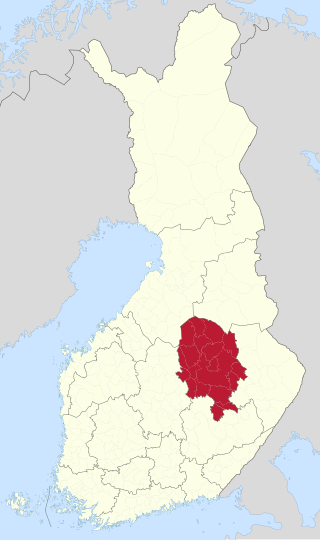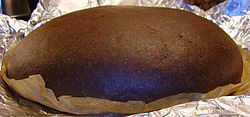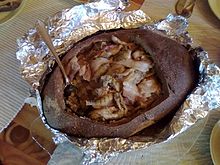
Finnish cuisine is notable for generally combining traditional country fare and haute cuisine with contemporary continental-style cooking. Fish and meat play a prominent role in traditional Finnish dishes in some parts of the country, while the dishes elsewhere have traditionally included various vegetables and mushrooms. Evacuees from Karelia contributed to foods in other parts of Finland in the aftermath of the Continuation War.

Meatloaf is a dish of ground meat that has been combined with other ingredients and formed into the shape of a loaf, then baked or smoked. The final shape is either hand-formed on a baking tray, or pan-formed by cooking it in a loaf pan. It is usually made with ground beef, although ground lamb, pork, veal, venison, poultry, and seafood are also used, sometimes in combination. Vegetarian adaptations of meatloaf may use imitation meat or pulses.

North Savo is a region in eastern Finland. It borders the regions of South Savo, Central Finland, North Ostrobothnia, Kainuu, and North Karelia. Kuopio is the largest city in the region and Lake Kallavesi is the largest lake in the region.

Russian cuisine is a collection of the different dishes and cooking traditions of the Russian people as well as a list of culinary products popular in Russia, with most names being known since pre-Soviet times, coming from all kinds of social circles.

Liver pate is a pâté and meat spread popular in Northern and Eastern Europe. Made from finely or coarsely ground pork liver and lard, it is similar to certain types of French and Belgian pâtés.

Jewish cuisine refers to the worldwide cooking traditions of the Jewish people. During its evolution over the course of many centuries, it has been shaped by Jewish dietary laws (kashrut), Jewish festivals and holidays, and traditions centred around Shabbat. Jewish cuisine is influenced by the economics, agriculture, and culinary traditions of the many countries where Jewish communities have settled and varies widely throughout the entire world.

Czech cuisine has both influenced and been influenced by the cuisines of surrounding countries and nations. Many of the cakes and pastries that are popular in Central Europe originated within the Czech lands. Contemporary Czech cuisine is more meat-based than in previous periods; the current abundance of farmable meat has enriched its presence in regional cuisine. Traditionally, meat has been reserved for once-weekly consumption, typically on weekends.

The Karelian hot pot (British) or Karelian stew (US) is a traditional meat stew originating from the region of Karelia. It is commonly prepared using a combination of pork and beef, but elk or lamb can also be used. Along with the Karelian pasties, it is the most widely recognized Karelian food in Finland. In 2007, it was selected as the national dish of Finland by the readers of the Finnish tabloid Iltalehti. In a similar poll organized by the ELO Foundation for the Promotion of Finnish Food Culture in cooperation with the Central Union of Agricultural Producers and Forest Owners (MTK) and the Finnish Ministry of Agriculture and Forestry in autumn 2016, Karelian hot pot took second place, losing to rye bread.

A loaf is a (usually) rounded or oblong quantity of food, typically and originally of bread. It is common to bake bread in a rectangular bread pan or loaf pan because some kinds of bread dough tend to collapse and spread out during the cooking process if not constrained; the shape of less viscous doughs can be maintained with a bread pan whose sides are higher than the uncooked dough. More viscous doughs can be hand-molded into the desired loaf shape and cooked on a flat oven tray.

Siopao, is a Philippine steamed bun with various fillings. It is the indigenized version of the Fujianese baozi, introduced to the Philippines by Hokkien immigrants during the Spanish colonial period. It is a popular snack in the Philippines and is commonly sold by bakeries and restaurants.

Tatar cuisine is primarily the cuisine of the Volga Tatars, who live in Tatarstan, Russia, and surrounding areas.
Traditional Estonian cuisine has substantially been based on meat and potatoes, and on fish in coastal and lakeside areas, however now bears influences from many other cuisines, including a variety of international foods and dishes, with a number of contributions from the traditions of nearby countries. German, Scandinavian and other influences have played their part. The most typical foods in Estonia have been fish, rye bread, barley, pork, potatoes and dairy products. Estonian eating habits have historically been closely linked to the seasons. In terms of staples, Estonia belongs to the Nordic cuisine area.

Bread is a staple food of Finland. It is served with almost every meal and many different types are produced domestically.

Nordic bread culture has existed in Denmark, Finland, Norway, and Sweden from prehistoric times through to the present. It is often characterized by the usage of rye flour, barley flour, a mixture of nuts, seeds, and herbs, and varying densities depending on the region. Often, bread is served as an accompaniment to various recipes and meals. Nordic breads are often seasoned with an assortment of different spices and additives, such as caraway seeds, orange zest, anise, and honey.

Ruisreikäleipä is a kind of Finnish bread, a flat rye flour loaf with a hole in the middle. It is sometimes referred to as reikäleipä, shorter term without ruis (rye) which applies also to the oat loaf with a hole.
Bread is a staple food throughout Europe. Throughout the 20th century, there was a huge increase in global production, mainly due to a rise in available, developed land throughout Europe, North America and Africa.
Kainuu people are Eastern Finnish inhabitants of the Kainuu region.















